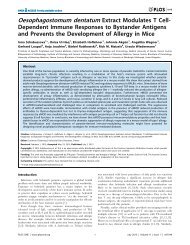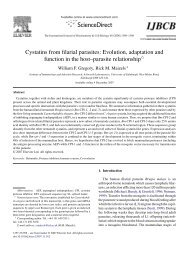Experimental Parasitology - Rick Maizels' Group - University of ...
Experimental Parasitology - Rick Maizels' Group - University of ...
Experimental Parasitology - Rick Maizels' Group - University of ...
You also want an ePaper? Increase the reach of your titles
YUMPU automatically turns print PDFs into web optimized ePapers that Google loves.
We therefore reasoned that if commensals modify host reponses to H. polygyrus, they are<br />
likely to do so through the established pattern recognition receptors such as Toll-like receptors<br />
(TLRs). Despite TLR9 playing a role in the recognition <strong>of</strong> commensal gut flora DNA (Hall, et al.,<br />
2008), TLR9 –/– show little difference in susceptibility following H. polygyrus infection, as was<br />
also found in mice with TLR2 deficiency. However, MyD88-deficient animals showed a<br />
consistently higher degree <strong>of</strong> resistance and greater level <strong>of</strong> granuloma formation (Reynolds,<br />
L.A., unpublished data). Hence, we currently postulate that different commensal species may<br />
promote or hinder development <strong>of</strong> immunity to H. polygyrus, but that the negative impact <strong>of</strong><br />
the microbiota is mediated through MyD88 signalling, possibly through redundant toll-like<br />
receptors.<br />
This hypothesis is supported by early studies, which found germ-free mice to be significantly<br />
more resistant to H. polygyrus infection than those harboring a conventional micr<strong>of</strong>lora<br />
(Wescott, 1968). Germ-free mice developed more numerous intestinal granulomas (Chang and<br />
Wescott, 1972) although no other immunological corrolates are available. Interestingly, the<br />
latter authors also reported that gnotobiotic mice, monocolonised with Lactobacillus bacteria,<br />
sustained longer-lasting infections than germ-free animals (Chang and Wescott, 1972),<br />
consistent with the notion that these micro-organisms may favour H. polygyrus survival.<br />
Moreover, the proportion <strong>of</strong> Lactobacillus/Lactococcus bacteria increase in the intestine <strong>of</strong> H.<br />
polygyrus-infected mice (Walk, et al., 2010) in a manner that shows a statistically significant<br />
positive correlation with worm burden (Reynolds, L.A., unpublished data).<br />
Parallels with human and animal gastrointestinal nematodes<br />
H. polygyrus is a Trichostrongyloid nematode, a member <strong>of</strong> the same taxonomic subfamily as<br />
major ruminant parasites (eg Haemonchus contortus, Teladorsagia circumcincta) that cause<br />
extensive pathology in livestock. They are also one step removed from the human hookworms<br />
(Ancylostoma duodenale and Necator americanus), which differ from H. polygyrus in that they<br />
are blood feeders. The degree to which H. polygyrus can serve as an authentic model for these<br />
veterinary and medical scourges is therefore <strong>of</strong> central importance.<br />
The close phylogenetic relationship between H. polygyrus and the ruminant Trichostrongylids<br />
appears to be upheld at the molecular level. For example, T. circumcincta also secretes a TGFβ-<br />
like molecule that induces regulatory T cells (Grainger, et al., 2010). More broadly, proteomic<br />
analyses <strong>of</strong> ES products from these species, as well as from the more divergent hookworms,<br />
show many similarities, including the abundance <strong>of</strong> VAL family members and the presence <strong>of</strong><br />
Maizels et al Hydra Special Issue Page 19





